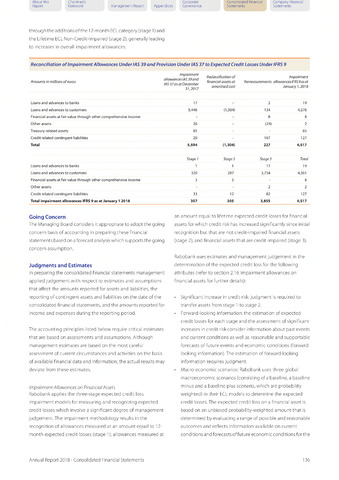About this
Report
Chairman's
Foreword
Management Report Appendices
Corporate
Governance
Consolidated Financial
Statements
Company Financial
Statements
through the additions ofthe 12-month ECL category (stage 1) and
the Lifetime ECL Non-Credit-Impaired (stage 2), generally leading
to increases in overall impairment allowances.
Reconciliation of Impairment Allowances Under IAS 39 and Provision Under IAS 37 to Expected Credit Losses Under IFRS 9
Amounts in millions of euros
Impairment
allowances IAS 39 and
IAS 37 as at December
31,2017
Reclassification of Impairment
financial assets a t Remeasuremen ts allowances IFRS 9 as at
amortised cost January 1,2018
Loans and advances to banks
Loans and advances to customers
Financial assets at fair value through other comprehensive income
Other assets
Treasury related assets
Credit related contingent liabilities
Total
17
5,446
26
85
20
5,594
(1,304)
(1,304)
2
134
8
(24)
107
227
19
4,276
8
2
85
127
4,517
Loans and advances to banks
Loans and advances to customers
Financial assets at fair value through other comprehensive income
Other assets
Credit related contingent liabilities
Total impairment allowances IFRS 9 as at January 1 2018
Stage 1
1
320
3
33
357
Stage 2
1
287
5
12
305
Stage 3
17
3,754
2
82
3,855
Total
19
4,361
8
2
127
4,517
Going Concern
The Managing Board considers it appropriate to adopt the going
concern basis of accounting in preparing these financial
statements based on a forecast analysis which supports the going
concern assumption.
Judgments and Estimates
In preparing the consolidated financial statements management
applied judgement with respect to estimates and assumptions
that affect the amounts reported for assets and liabilities, the
reporting of contingent assets and liabilities on the date ofthe
consolidated financial statements, and the amounts reported for
income and expenses during the reporting period.
The accounting principles listed below require critical estimates
that are based on assessments and assumptions. Although
management estimates are based on the most careful
assessment of current circumstances and activities on the basis
of available financial data and information, the actual results may
deviate from these estimates.
Impairment Allowances on Financial Assets
Rabobank applies the three-stage expected credit loss
impairment models for measuring and recognizing expected
credit losses which involve a significant degree of management
judgement. The impairment methodology results in the
recognition of allowances measured at an amount equal to 12-
month expected credit losses (stage 1); allowances measured at
an amount equal to lifetime expected credit losses for financial
assets for which credit risk has increased significantly since initial
recognition but that are not credit-impaired financial assets
(stage 2); and financial assets that are credit-impaired (stage 3).
Rabobank uses estimates and management judgement in the
determination ofthe expected credit loss for the following
attributes (refer to section 2.16 Impairment allowances on
financial assets for further details):
Significant increase in credit risk: judgment is required to
transfer assets from stage 1 to stage 2.
Forward-looking information: the estimation of expected
credit losses for each stage and the assessment of significant
increases in credit risk consider information about past events
and current conditions as well as reasonable and supportable
forecasts of future events and economic conditions (forward
looking information). The estimation of forward-looking
information requires judgment.
Macro-economic scenarios: Rabobank uses three global
macroeconomic scenarios (consisting of a baseline, a baseline
minus and a baseline plus scenario, which are probability
weighted) in their ECL models to determine the expected
credit losses. The expected credit loss on a financial asset is
based on an unbiased probability-weighted amount that is
determined by evaluating a range of possible and reasonable
outcomes and reflects information available on current
conditions and forecasts of future economic conditions for the
Annual Report 2018 - Consolidated Financial Statements
136

